A Little History of Microcosm & Publishing—in comic form!
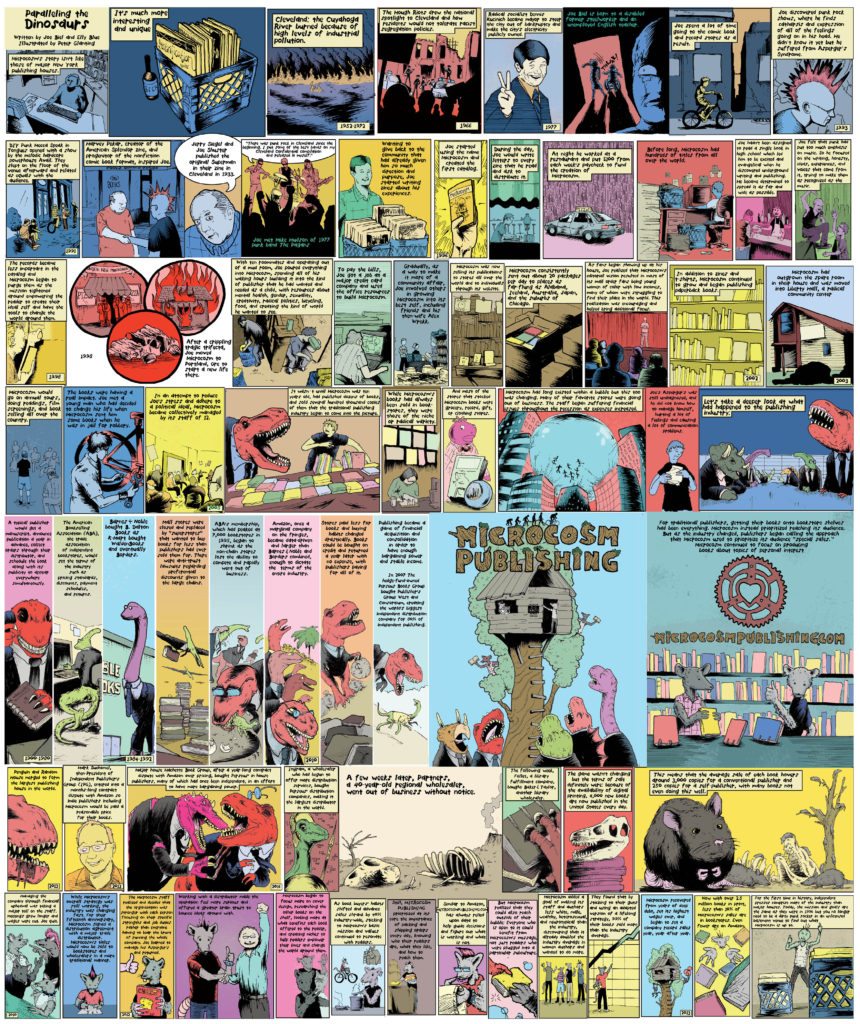
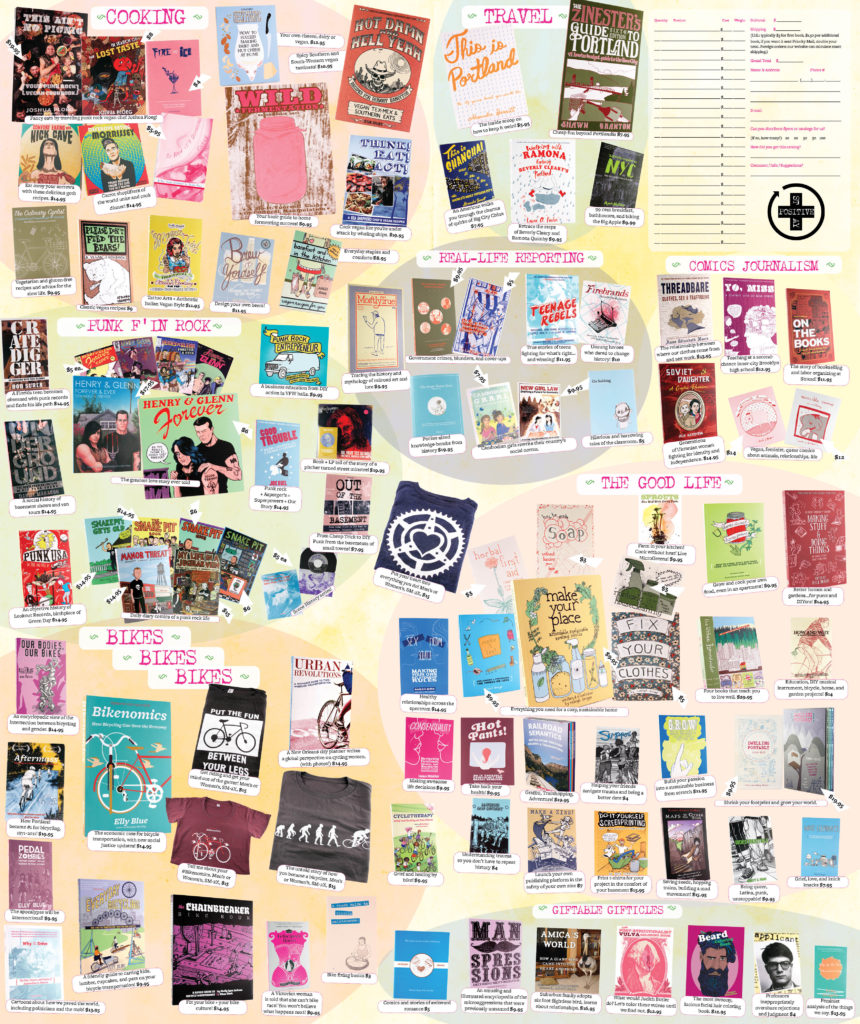


This is the ninth post in our ongoing Business of Publishing series by Joe Biel, the author of A People’s Guide to Publishing. This edition tackles an important but more advanced question, “how much can I afford to spend on the book that I am publishing?”
While, on the surface, any answer to a question like this seems to be built from a steady diet of bullshit, books are remarkably consistent. Unlike cookies or soft drinks, most books are not branded. A book from a major house sits next to your book and others from indie presses. If you’ve successfully developed your book, you are providing each reader with enough information to make a choice based on their own experiences, observations, and tastes.
Let’s begin! For those following along at home, I’ve created this spreadsheet that you can download or duplicate and edit. And as you’ll see, there are fairly predictable formulas for everything.
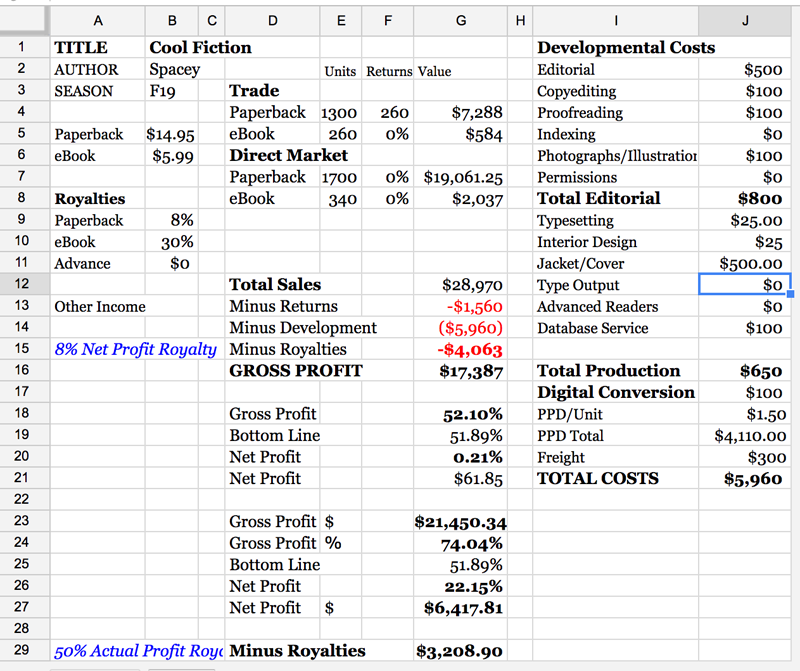
The upper left hand corner begins with the title, author, and book’s release season. Lines 5 and 6 include retail prices for each format. If you’re doing a hardcover, you’d include that as well. Lines 9 and 10 list the author’s royalty by format as well as any advance payment that they receive. Traditionally this advance is your projected first two years of royalties paid in advance.
Line 13 is income from selling film or translation rights or foreign territory rights but it’s best not to plan for this in advance since even commitments can fall apart as the licensee changes their plans.
Beginning in column D, lines 4-5 predict what will likely be the sales in bookstores as well as returns and revenues. These numbers are based on your comparable titles and their selling habits. It’s best to be conservative here so that your expectations are reasonable and you aren’t shocked when you see your actual sales and returns.
Lines 7-8 predict similar sales in the direct market, which would include sales at your own events, via your own website, to non-trade stores that buy non-returnable, and books sold to the author. Again, these numbers should be conservative and based on figures in reality that you are seeing elsewhere.
Scooting over to column I, we’re looking at the publisher’s expenses for putting the book together from editorial to production to licensing to eBook conversion to paper, printing, and binding costs. Fiddle with these numbers to see what you can afford for a project before committing with an author.
Next, back on column D and lines 12-16, we’re looking at sales minus returns minus development costs minus author royalties. This will tell you what your gross profit is.
Next, we subtract operating costs (“the bottom line”), like rent, staff, telephones, envelopes, warehousing, etc. These should comprise every expense that you’ll have to pay for even if you don’t work on a book during a given month. Subtracting your gross profit from your bottom line will tell you how much actual profit the publisher is earning from each book. In this example, it’s less than $62. This example represents the most statistically likely outcome for a book like this. Publishing is about volume so to make up for these low returns, you can either produce tons and tons of books (called a “paper mill” in the industry”) or land a few heavy hitters every year. Your choice, kind of.
Another vital part of the P&L is to evaluate a year or two later how well the book did against expectations. If a book does not sell as well as expected, it’s important to figure out why. Was tons of new competition added? Did interest in the subject fade away? Was it revealed that the author’s cure for cancer was actually bogus and their credibility tanked? Was there a major developmental error in the cover/title/subtitle that confused readers about what the book offered or how it was unique? Answer these questions. Similarly, if a book did better than expected, it’s similarly important to figure out why and repeat these events with other titles.
Alternately, to demonstrate how these traditional contracts still benefit the author, I showed an alternate royalty model where the author takes 50% of the profit. But as you can see, comparing cell G29 to G15, 8% of the cover price ends up being more than 50% of gross profit in most cases until you really land a bestseller.
Due to Amazon’s immense marketing budget and campaign to convince authors that publishers are greedy and obsolete, many authors don’t understand why the traditional 4-8% paperback royalty is still much more in their favor than self-publishing on Kindle and CreateSpace so I’ve made a chart for that too.
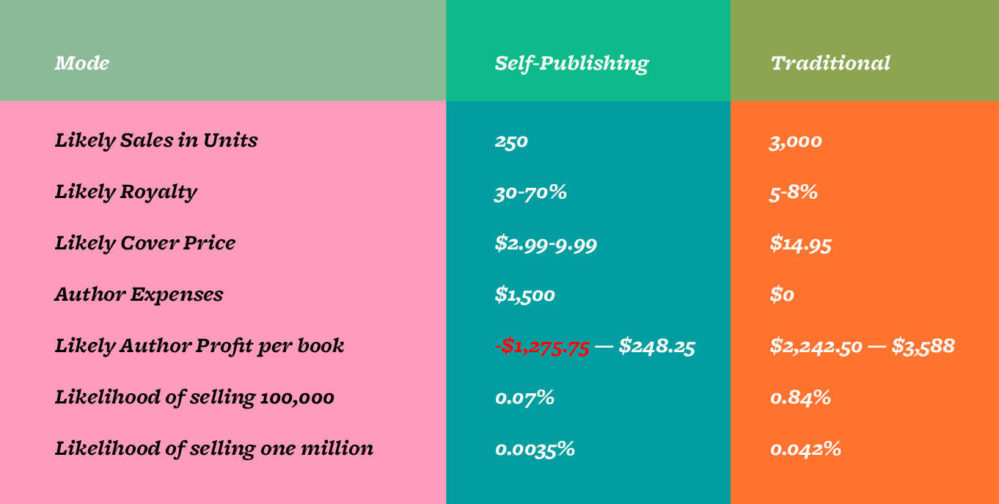
Co-founder of the Why Not? Fest in Minot, North Dakota, Jazmine is a shining beacon that you can change your community by getting involved and rocking and rolling. She loves to be organized. People that don’t do what they agreed to get under her skin. She shows us how even tragedies like suicide can inspire communities to create the greatest memorial music festival.
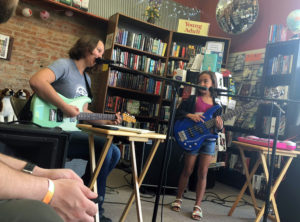
Rocking & rolling with her eight-year-old bandmate.

Jazmine painstakingly hand painted this sign in 2015.
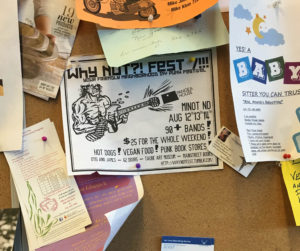
The punk festival. Promoted at the local grocery store.
 On Valentine’s Day in 2013 I finally brought home Ruby, my medical alert service dog, after years of meetings, phone calls, paperwork, and interviews. She’s been a wonderful angel for most of the time since but every day when we go to work she would be stuck sleeping on my the floor next to my chair. She would periodically look up at me, pleadingly. One thing that I hadn’t realized when I had applied for her was that a dog’s range of emotions is identical to a human’s and that Ruby and I were in a committed relationship. I had to look out for her, make her feel loved, and take care of her.
On Valentine’s Day in 2013 I finally brought home Ruby, my medical alert service dog, after years of meetings, phone calls, paperwork, and interviews. She’s been a wonderful angel for most of the time since but every day when we go to work she would be stuck sleeping on my the floor next to my chair. She would periodically look up at me, pleadingly. One thing that I hadn’t realized when I had applied for her was that a dog’s range of emotions is identical to a human’s and that Ruby and I were in a committed relationship. I had to look out for her, make her feel loved, and take care of her.
Fortunately, I took quite naturally to this situation. She sleeps in bed with me, leaning against my leg. When I sit on the couch she wants to be napping on my lap. But our work arrangement was not as easily resolved as our home life. I began letting her nap on my lap when I was sitting in my office chair. But she would nervously perk up whenever the chair rotated or leaned and my legs would go numb under her in less than an hour.
I knew that the situation called for desperate measures. Ruby’s work and our relationship allowed me to safely go places unescorted. I swapped out my desk for a series of filing cabinets, attached a monitor arm to one of them, and ordered a mounted swivel tray for my keyboard, mouse, and beverage. I swapped out my chair for the office futon and now not only can Ruby and I take office naps but she can sit next to me all day long and snore as she leans against me, still paying attention to my blood glucose. When we arrive at the office every morning, she immediately bounds over to the futon and pleads me to join her.
Founder of Top Shelf Comix’s Brett Warnock, has seen quite a bit. From the rise of indie comics to saturation of web and self-publishing, he turned to his second career as a nature and food writer and photographer. Listen here.
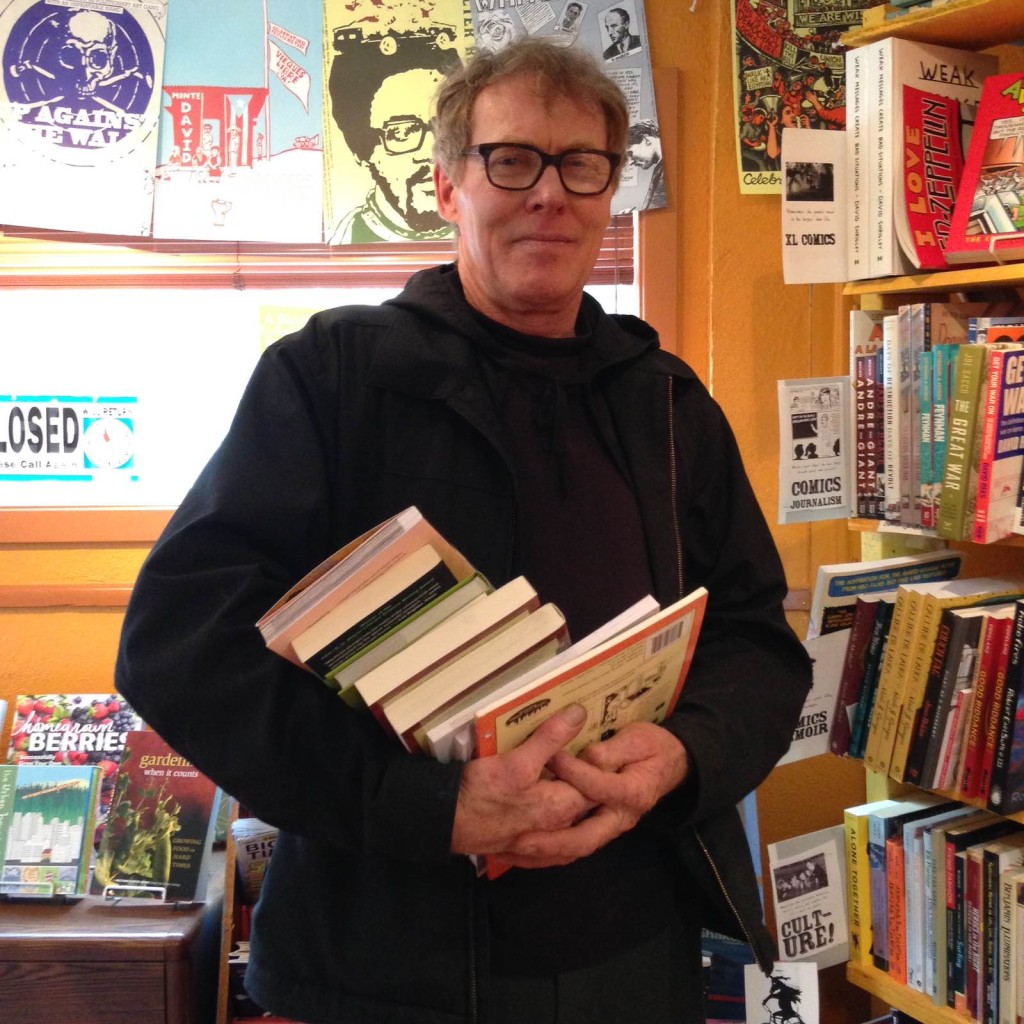 On a rainy day in the year 2000 I received a phone call from a man desperately trying to convince me to let him come visit Microcosm’s warehouse. Microcosm’s warehouse at the time was a 12×6’ room in the basement of my home and doubled as my office. A little nervous, I agreed but made him wait in my living room while I grabbed everything. It would be difficult for both of us to fit in the Microcosm room without first removing my desk. Tom bought over 90% of the zines and books that I had in stock. He also asked about many things that I was sold out of. I had to literally reorder everything that week.
On a rainy day in the year 2000 I received a phone call from a man desperately trying to convince me to let him come visit Microcosm’s warehouse. Microcosm’s warehouse at the time was a 12×6’ room in the basement of my home and doubled as my office. A little nervous, I agreed but made him wait in my living room while I grabbed everything. It would be difficult for both of us to fit in the Microcosm room without first removing my desk. Tom bought over 90% of the zines and books that I had in stock. He also asked about many things that I was sold out of. I had to literally reorder everything that week.
I figured that I’d never hear from him again but a month later he called, asking to come back. This time I let him join me in the Microcosm room. Despite being 6’7”, Tom did not bat an eye at having to crouch under the ceiling that I had built to be exactly 6’4” over my head, so I would only have to dodge the bare light bulbs. Tom again bought almost everything and this cycle continues sixteen years later. Only now he visits our store weekly and still leaves a lack of books in his wake.
You see, Tom refuses to use the Internet. Hell, he refuses to even look at a screen. He lives in a cabin in the woods without electricity or running water. His neighbor criticizes him for having a store-bought plastic cooler. Even as modern books couting has evolved into an Internet hunt, Tom has remained refreshingly analog, just like books. He claims that even Aaron Cometbus, a longtime holdout against using computers, finally gave in and expresses regret to Tom for doing so.
Tom is clearly inspired by the book hunt and his built a weekly routine of coming into the city every Wednesday and buying books. He constantly sends customers our way for an “authentic Portland experience” and brings us freshly picked huckleberries from the woods. Tom’s ethics and routines are a firm reminder of why we do the things that we do at Microcosm: to create resources for people who don’t have access to them otherwise so they can change their lives for the better. And while his bookstore, Artifacts in Hood River, has gradually been treated more and more like a gift shoppe for windsurfing tourists, we can still achieve our missions together. Perhaps it’s the perfect irony that Tom will never be able to read this love note.
 It’s estimated that last year adult coloring books added $50M to publishing industry sales, creating a record sales year. But Microcosm sort of operates like that island in Lost where we hear only infrequent communications from the mainland and happily can focus on the kinds of things we want to say to the world rather than responding to every peculiar news cycle. And one day, under those conditions, we realized that the Cunt Coloring Book was constantly out of stock so we decided to produce The Vulva Coloring Book to be more factually accurate but also because the former was over 40 years old.
It’s estimated that last year adult coloring books added $50M to publishing industry sales, creating a record sales year. But Microcosm sort of operates like that island in Lost where we hear only infrequent communications from the mainland and happily can focus on the kinds of things we want to say to the world rather than responding to every peculiar news cycle. And one day, under those conditions, we realized that the Cunt Coloring Book was constantly out of stock so we decided to produce The Vulva Coloring Book to be more factually accurate but also because the former was over 40 years old.
Naturally, within a few weeks Elly had the idea to add post-structuralist theory to the book and it became The Post-Structuralist Vulva Coloring Book. Slowly, as we learned about the huge adult coloring book trend, the book became a way to challenge gender stereotypes and make commentary about how women are shamed about their bodies in so many ways and it can often be difficult to discuss these things.
The book slowly became (as far as I understand it) a way to make fun of the inherent meaninglessness of post-structuralism in a way that could read as “authentic” to people who were actually familiar with it while challenging people’s conceptions of bodies and gender. And for once we happen to be synched up with the trends to get a few more inches on our agenda with this book!
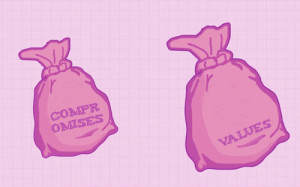 I work twelve-hours almost every day, including weekends. Almost every time that I explain how little I earn to the people who see how hard I work, they are puzzled. How do I make it work? Why would I make these “compromises?” What if something happens to me? What am I going to do for retirement?
I work twelve-hours almost every day, including weekends. Almost every time that I explain how little I earn to the people who see how hard I work, they are puzzled. How do I make it work? Why would I make these “compromises?” What if something happens to me? What am I going to do for retirement?
It’s been a long time since publishing has been an industry that people pursue for money. But what the above (well intentioned) concerns don’t take into account is that there are far more important things than money.
To me publishing has always been about pursuing my values without compromise. It’s a way to give rise to voices that don’t get heard. It’s a way to challenge popular but stupid narratives. It’s a way that I don’t need to seek outside approval or funding to tell the world what I think is vitally important. And those values are so much more important to me than money that I’ve worked without any compensation at all during three different periods in Microcosm’s history. It was more important to continue to do this work than it was to get paid even though that meant that I had to work a second (and sometimes third) job to make that happen.
These days, things are a bit more relaxed. I’ve been trying to take the weekends off with varying success. I recently have been quizzing people about what others do on vacation and everyone tells me a variation of “Impulsively do exactly what you want, when the muse strikes you.” But that’s what I do every day.
Last night I did an interview about Good Trouble: Building a Successful Life & Business with Asperger’s for New Noise Magazine that ran about 75 minutes. We talked about the motivations for Microcosm and quite a bit about how Asperger’s affected my life and compared stories about other people that we know with Asperger’s and how it affects them.
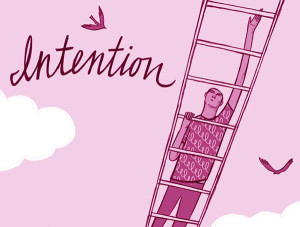
It struck upon a thought that I’ve had for a while. As a person with Asperger’s I’ve often found myself upsetting people for reasons that I couldn’t understand. But the more that I learn about the incredible complexity of emotional communication, the more I realize how contextual it is. The average person has no idea what it’s like to navigate the world with a disability but even after I explain that what someone perceives as rudeness or insensitivity is a result of Asperger’s Syndrome rather than my own callousness, their feelings are still hurt. Their feelings are also real and valid. They don’t simply go away once someone can intellectually understand what caused them. I’ve learned the hard won lessons that more often than not, other people want to feel heard rather than to resolve whatever transgression has happened between us.
And similarly, I’ve watched hundreds of people slowly learn the lesson that they can hurt someone’s feelings even if their intentions were good. Our intentions don’t change the harm that we can cause to other people. And given that my empathy is product of my intellect rather than a natural process transferred from the mirror neurons in my brain, this confuses me. But at least knowing this stuff helps tremendously as life moves on not to harm other people.
 Last month I was invited to speak on a panel about the arts. I agreed and a month later I received another email, explaining that a woman panelist had canceled and had been replaced with a man. The curator was concerned that having a panel with four men and only one woman might appear to have a lack of diversity. It’s certainly an important thing to consider when putting on a public event. The recent social justice movements around race and gender have gotten gears grinding in people’s heads. At the same time numerous people have expressed to me just how patronizing it feels when the stated reason for sending them an invitation is because of their race or gender, rather than the merit of their work or just how brilliant they are in the first place.
Last month I was invited to speak on a panel about the arts. I agreed and a month later I received another email, explaining that a woman panelist had canceled and had been replaced with a man. The curator was concerned that having a panel with four men and only one woman might appear to have a lack of diversity. It’s certainly an important thing to consider when putting on a public event. The recent social justice movements around race and gender have gotten gears grinding in people’s heads. At the same time numerous people have expressed to me just how patronizing it feels when the stated reason for sending them an invitation is because of their race or gender, rather than the merit of their work or just how brilliant they are in the first place.
None of these ideas are groundbreaking or unique, but they keep leading me to another thought: When considering public perception of the composition of an event or organization, curators and boards think of diversity in terms of a visual analysis rather than a contextual one. On the surface I’m a white man. At the same time I would bet you that I will be the only panelist that didn’t go to college, let alone one that cost more than my annual income. I suspect that I will also be the only neurodiverse panelist and the only physically disabled one as well. I can tell you this because it’s been true of almost every panel that I’ve been on in my life. The room often gets awfully awkward when people try to compare childhoods or stories with me, because, frankly, my life is so different from almost anyone that tries to relate with me—especially other people that work in publishing or bicycle advocacy.
Obviously these lived experiences inform my perspective and sensitivities but also my take on any subject that I discuss. And often the behaviors that I exhibit as a result of these things is the very reason that I’m not invited to be a part of speaking events in the first place. Social justice movements have done a tremendous service for society by creating an awareness and new language around inclusion and I’m proud to be part of the leading edge of challenging around class and neurodiversity as well!